In 1904 the artist Frederick Samuel Dellenbaugh wrote of the landscape that became Zion National Park: “Never before has such a naked mountain of rock entered into our minds!… There is almost nothing to compare to it. Niagara has the beauty of energy; the Grand Canyon, of immensity; the Yellowstone, of singularity; the Yosemite, of altitude; the ocean, of power; this great temple, of eternity.” Recalling prehistoric dunes and vanished seas, Zion appears at once infinite and ever-eroding.
We asked Ethan Newman, author of the Zion Mountain Profile in our latest issue, to select passages from his piece for publication online.
Alpinist 53 is on newsstands now. It’s also available for digital download with our iTunes app as well as at the other popular digital newsstand apps Zinio and Nook.
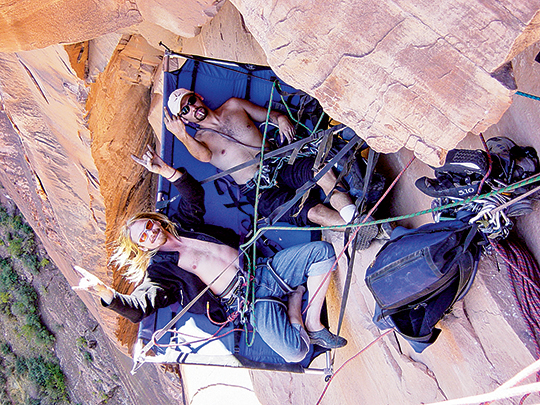
[Photo] Ammon McNeely
The statement of the West Temple is still in your face each moment you linger in town. Its stark, natural lines dare you to dream of creating your own paths in the desert, while route names like Gettin’ Western remind you of the absurdity. I like to think of it as a symbol of another Zion ethic: take the climbing seriously, not yourself.
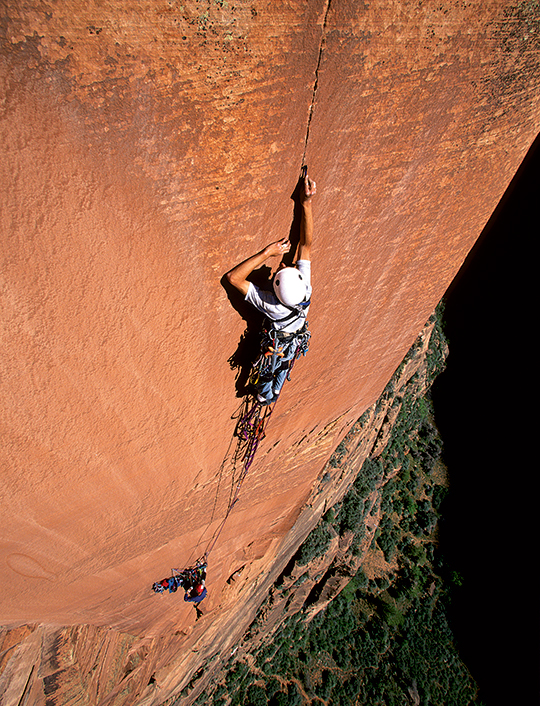
[Photo] Eric Draper
On an otherwise clean sweep of vermilion rock, a climber reaches up, fiddling a tiny beak piton into a barely perceptible inconsistency in the hairline seam. The rope snakes down through equally minuscule protection to the belayer. The wall falls for 700 feet to trees that look like broccoli. The caption of this poster, showing the second ascent of Dark Side of the Moon, reads simply, ZION: It’s not for beginners. If you look closer and draw your eye away from the disconcertingly thin crack, you might see a child’s sword dangling from Bryan Bird’s harness. The toy adds an air of absurdity, even silliness, to an otherwise dangerous position. While most visiting climbers (and even locals) find the walls of Zion intimidating, some have spent so much time with these stone giants that they might even share a joke with them.
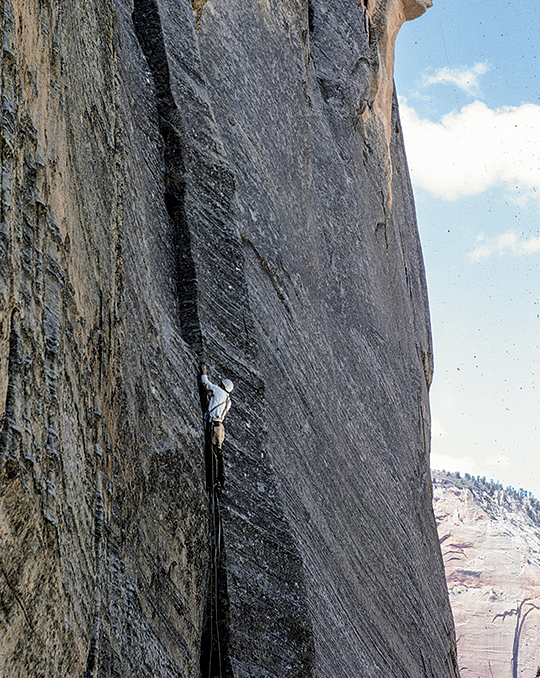
[Photo] Pat Callis collection
[Galen] Rowell, an experienced mechanic, fabricated additional pieces of protection out of four-and-a-half-inch lag screws from a nearby hardware store. These would be crucial for smooth patches high on the Throne. The next morning the rain returned. [Fred] Becky was fed up. “This fucking weather is ruining my life,” he said, and the team left for sunnier objectives.
Two weeks later, Becky, [Pat] Callis, and Rowell were back in Zion. After a brief spring squall of thunder and snow, the skies cleared. Past their high-point, they aided to Last Chance Ledge, where they spent the night by a campfire, preparing for a summit bid. They advanced slowly, relying on pitons in cracks, lag screws in blank sections, and a twelve inch Austrian ice piton as part of the belay. They were almost to the top when Callis heard angry curses above him: Becky had convinced Rowell to step on a dead tree, which snapped off and crashed to the earth. A little higher, a piton blew out. This time, Rowell flew through the air, stopping only when a sling around a small tree caught him. “By this time,” Callis noted, “Galen’s language began to betray certain personal feelings.” Undaunted, Rowell aided off an ice screw to surmount the final overhangs. From the top of a surreal “desert wonderland,” they looked out on the canyon glowing and fading into dusk.
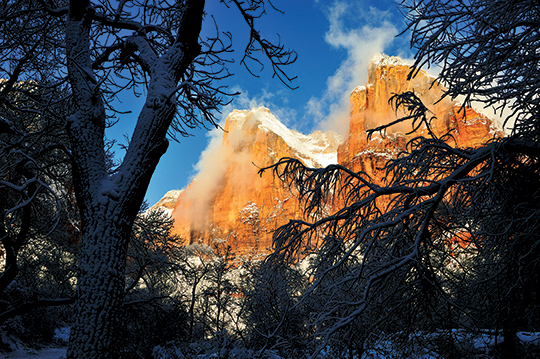
[Photo] Keith Ladzinski
Paiute stories describe a landscape filled with legends: Kai-ne-sava, a spirit who might roll rocks down the cliffs, set the mesa tops on fire, send ravens to eat your food, or help with your hunting–depending on his mood. Wynopits was an evil spirit, lurking in the shadows and dark places. Sina-wava, the Coyote god, was more friendly, although perhaps more aloof. Alvin Marble recounted a song to [William Logan] Hebner about a hunter who scrambled up a cliff in Zion Canyon while trying to fetch a mountain sheep he’d shot with a bow and arrow. High above the ground, the hunter fell. When he came to, he found himself strangely uninjured, below the cliff. “He didn’t know how he got there,” Marble said. “The mountain sheep had brought him down.”
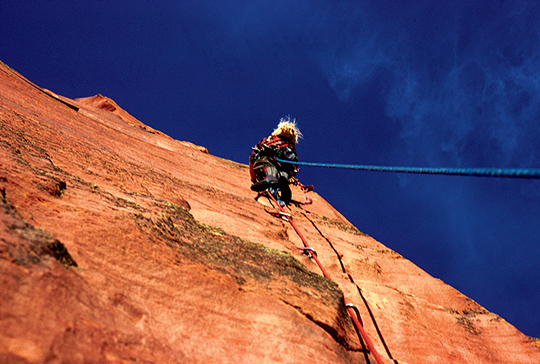
[Photo] Jeff Lowe collection
Two days later at dusk, while his partners rested on the top of the headwall, [Jeff] Lowe scrambled alone through the violet air and built a cairn on the summit. It was an act he later regretted: a sign of “ego.” He felt troubled, as well, during their descent off the back side into quiet hanging canyons. “Here we find a perfect carpet of green moss growing precariously on a sandy bottom,” he wrote. “We make the mistake of trampling over the fragile lawn….Well meaning men, we are the first of our kind to leave our destructive mark on this wild place.”
Inside Alpinist 53 is the full 30-page Zion Mountain Profile. The piece traces the human history of its great sandstone walls, from tales of indigenous cliff dwellers to modern climbers–including pros and photos that span decades of exploration. In his Zion essay, Wind Sand and Time, Ethan Newman speaks with many of the local protagonists and asks: How will the forces of erosion, human impact and climate change shape the landscape over the next 100 years? “All the incarnations of this place–the sea of dunes, Mukuntuweap, the Monument, a National Park–sit atop each other like strata. The stories we tell expose the layers, showing the cross-bedding of history,” he writes.